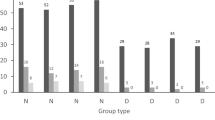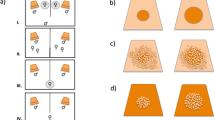Summary
Pseudocrenilabrus multicolor is an iteroparous maternal mouthbrooding cichlid fish living in small and shallow waters in East Africa. It is subjected to large seasonal variations of population density. Laboratory experiments show that with increasing density and time after spawning the number of offspring present in the mouth decreased. By experimentally varying density and the numbers of fertilized and unfertilized eggs in the mouth at the end of spawning the following causes of brood size reduction were identified: (1) At high densities some of the spawned eggs are stolen by conspecifics before they are taken into the mouth. Of the eggs taken up a considerable proportion is unfertilized. (2) Unfertilized eggs are selectively swallowed from day 2 to day 5 after spawning. (3) Some of the fertilized eggs are also swallowed during mouthbrooding. (4) If the number of eggs in the mouth falls below a critical value of approximately 20% of the number of eggs spawned, they are all swallowed. By contrast, predation by conspecifics is insignificant as long as the brood is in the mother's mouth. The causes and functions of the mother's filial cannibalism are discussed.
Similar content being viewed by others
References
Assem J (1967) Territory in the three-spined stickleback, Gasterosteus aculeatus L. Behaviour [Suppl] 16:1–164
Chang BD, Liley NR (1974) The effect of experience of the development of parental behavior in the blue gourami, Trichogaster trichopterus. Can J Zool 52:1499–1503
DeMartini EE (1976) The adaptive significance of territoriality and egg cannibalism in the painted greenling, Oxylebius pictus Gill., a Northeastern Pacific marine fish. PhD thesis, University of Washington, Seattle, WA
Dominey WJ (1981) The mating system of the bluegill sunfish (Centrarchidae: Lepomis macrochirus). PhD thesis, Cornell University, Ithaca, NY
Dominey WJ, Blumer LS (1984) Cannibalism of early life stages in fishes. In: Hausfater G, Hrdy SB (eds) Infanticide. Comparative and evolutionary perspectives. Aldine, New York, pp 43–64
Ferguson GA (1965) Nonparametric trend analysis. McGill Univ Press, Montreal
Fisher RA (1930) The genetical theory of natural selection. Oxford University Press, Oxford
FitzGerald N, Havre N van (1987) The adaptive significance of cannibalism in sticklebacks (Gasterosteidae: Pisces). Behav Ecol Sociobiol 20:125–128
Fryer G, Iles TD (1972) The cichlid fishes of the Great Lakes of Africa: Their biology and evolution. Oliver and Boyd, Edinburgh
Greenwood PH (1965) The cichlid fishes of Lake Nabugabo, Uganda. Bull Br Mus Nat Hist Zool 12:315–357
Gunter G (1947) Observations on breeding of the marine catfish, Galeichthys felis (Linneaus). Copeia: 217–223
Hausfater G, Hrdy SB (eds) (1984) Infanticide. Comparative and Evolutionary Perspectives. Aldine, New York, pp 598
Hrdy SB (1979) Infanticide among animals: A review, classification, and examination of the implications for the reproductive strategies of females. Ethol Sociobiol 1:13–40
Keenleyside MHA (1979) Diversity and adaptation in fish behaviour. Springer, New York Berlin Heidelberg
Kramer DL (1973) Parental behaviour in the blue gourami Trichogaster trichopterus (Pisces, Belontiidae) and its induction during exposure to varying numbers of conspecific eggs. Behaviour 47:14–32
Liebman E (1933) Some observations on the breeding habits of Palestine Cichlidae. P Zool Soc Lond: 85–87
Lienert GA (1973) Verteilungsfreie Methoden in der Biostatistik. Bd 1. Hain, Meisenheim am Glan
Loiselle PV (1983) Filial cannibalism and egg recognition by males of the primitively custodial teleost Cyprinodon macularius californiensis girard (Atherinomopha: Cyprinodontidae). Ethol Sociolbiol 4:1–9
Lowe-McConnell RH (1975) Fish communities in tropical freshwaters. Longman, New York
Lowe-McConnell RH (1979) Ecological aspects of seasonality in fishes of tropical waters. Symp zool Soc Lond 44:219–241
Mrowka W (1982) Untersuchungen zum Entstehen der Brutpflegebereitschaft des Kleinen Maulbrüters Pseudocrenilabrus multicolor (Cichlidae). Z Tierpsychol 58:1–24
Mrowka W (1984a) Brood care motivation and hunger in the mouthbrooding cichlid Pseudocrenilabrus multicolor. Behav Process 9:181–190
Mrowka W (1984b) Is the parental care behaviour of Aequidens paraguayensis (Cichlidae) optimal? Behaviour 89:128–146
Mrowka W (1986) Satiation restores brood care motivation in the female mouthbrooder Pseudocrenilabrus multicolor (Cichlidae). Physiol Behav 38:153–156
Mrowka W (1987a) Egg-stealing in a mouthbrooding cichlid fish. Anim Behav 35:923–925
Mrowka W (1987b) Oral fertilization in a mouthbrooding cichlid fish. Ethology 74:293–296
Peters HM (1937) Experimentelle Untersuchungen über die Brutpflege von Haplochromis multicolor, einem maulbrütenden Knochenfisch. Z Tierpsychol 1:201–218
Pianka ER, Parker WS (1975) Age-specific reproductive tactics. Am Nat 109:453–464
Reinboth R (1956) Untersuchungen zur Maulbrutpflege von Haplochromis multicolor (Hilgendorf). Zool Jb (Physiol) 66:217–272
Rohwer S (1978) Parental cannibalism of offspring and egg raiding as a courtship strategy. Am Nat 112:429–440
Siegel S (1956) Nonparametric statistics for the behavioral sciences. McGraw-Hill, New York Toronto London
Staeck W (1973) Cichliden. Verbreitung, Verhalten, Arten. Pfriem, Wuppertal, pp 317
Taborsky M (1985) On optimal parental care. Z Tierpsychol 70:331–336
Welcomme RL (1967) The relationship between fecundity and fertility in the mouthbrooding cichlid fish Tilapia leucosticta. J Zool 151:453–468
Wickler W (1962) El-Attrappen and Maulbrüten bei afrikanischen Cichliden. Z Tierpsychol 19:129–164
Wickler W, Seibt U (1983) Optimal maternal care. Z Tierpsychol 63:201–205
Author information
Authors and Affiliations
Rights and permissions
About this article
Cite this article
Mrowka, W. Filial cannibalism and reproductive success in the maternal mouthbrooding cichlid fish Pseudocrenilabrus multicolor . Behav Ecol Sociobiol 21, 257–265 (1987). https://doi.org/10.1007/BF00292507
Received:
Accepted:
Issue Date:
DOI: https://doi.org/10.1007/BF00292507




